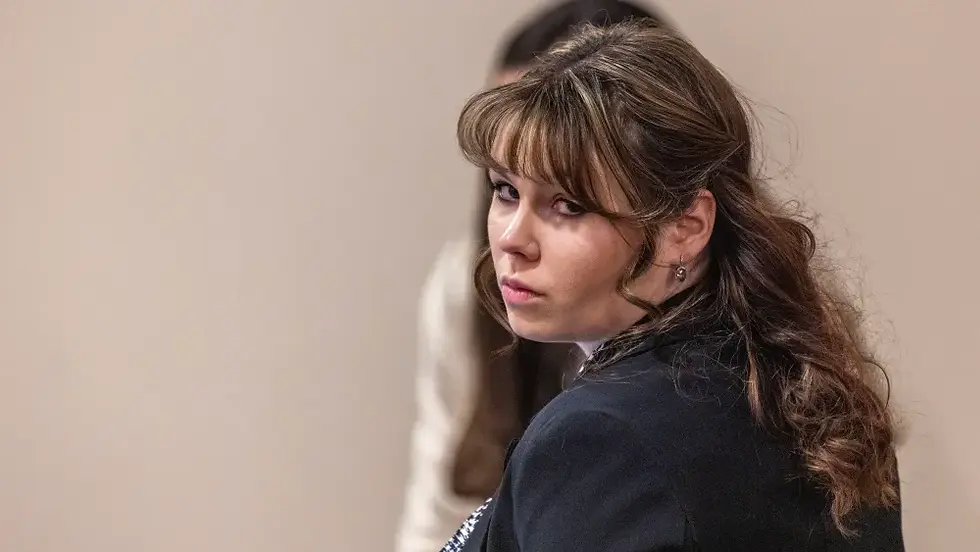Neglect for Film Safety? "Rust" Armorer Found Guilty!
- Joanna song
- Mar 9, 2024
- 3 min read
In 2021, cinematographer Halyna Hutchins was killed in a tragic shooting on the film set of Rust. The incident occurred during a rehearsal on set in New Mexico, where actor Alec Baldwin discharged a revolver, firing a live round that tragically killed Halyna Hutchins and injured the film's director, Joel Souza.
Since then, Baldwin has maintained his innocence, asserting that he was assured the gun was free of live ammunition, as per industry standards banning live rounds on sets. Baldwin also denies directly pulling the trigger, contending that the discharge occurred when he cocked and released the hammer.

While Baldwin awaits trial this July, recently a New Mexico jury delivered a verdict of involuntary manslaughter against Hannah Gutierrez- Reed the armorer of the set. Reed has been charged for inadequately inspecting the ammunition and permitting live rounds on the film set. Consequently, the outcome of this trail underscores the complexities and responsibilities inherent in the filmmaking process, shedding light on the crucial role of safety protocols and accountability on set.

Beyond the courtroom drama, this case prompts a broader conversation about the need for heightened safety measures and enhanced training within the film industry. The loss of Halyna Hutchins serves as a reminder of the risks faced by professionals in the pursuit of cinematic excellence, underscoring the imperative for proactive measures to prevent such tragedies in the future.
Variety magazine reached out to individuals within the industry, including DP Nancy Schreiber, a member of the American Society of Cinematographers, who expressed anger and distress over the lack of adherence to safety protocols. Schreiber emphasized the seriousness of the situation by stating:
"The negligence of loading live ammunition near a film set and the disregard for protocol by both the armorer and the first AD is unacceptable in our industry, where safety standards must always take precedence."

As the film community grapples with the aftermath of this incident, there is an opportunity for introspection and reform. From reevaluating safety protocols to fostering a culture of transparency and communication, there are tangible steps that can be taken to mitigate risks and prioritize the well-being of all involved in the filmmaking process.
Veteran producer Toni-Ann Lagana explains that despite the best efforts of seasoned professionals to maintain safety on set, recurring incidents persist for several reasons. One primary factor is the relentless push to complete filming under constrained budgets and increasingly tight schedules. As a result, many sets are driven by the desire to outpace competitors in reaching the market.
Consequently, this pressure fosters an atmosphere where individuals on set may prioritize speed over caution, fearing repercussions for any disruptions to the production timeline. This incentive undermines creating a safe working environment, potentially endangering lives in the process.
Furthermore, budget cuts frequently result in crew downsizing, amplifying risks by reducing resources such as security personnel and dedicated staff responsible for overseeing filming procedures. This downsizing also leads to individuals assuming multiple roles, stretching their attention thin and increasing the likelihood of errors due to divided focus.
Although high profile accidents such as "Rust" have garnered a lot of attention, they often fail to provoke substantial industry-wide change. Despite occasional media coverage, there is a notable lack of follow-up regarding the root causes of such incidents or efforts to prevent their recurrence. The tendency to dismiss such occurrences with settlements or assurances of isolated incidents contributes to a desensitizing effect, perpetuating a cycle of neglect rather than fostering accountability and reform.
Whether it's a home improvement program or any production set, there's an inherent level of risk that necessitates careful precautions. However, when instances of negligence occur repeatedly, regardless of the scale, they tend to become normalized within the industry. These seemingly minor incidents, if left unaddressed and unreported to relevant unions where applicable, accumulate over time.
The notion of "the show must go on" becomes perilous when critical safety issues, both on and off the set, remain unaddressed. Open dialogue and proactive measures are essential for prioritizing the well-being of everyone involved in production.
Ultimately, the verdict in the Gutierrez-Reed trial serves as a pivotal moment for the industry, prompting a renewed commitment to ensuring that every individual on set can pursue their craft in a safe and supportive environment. The legacy of Halyna Hutchins demands nothing less than a comprehensive reevaluation of practices and a steadfast dedication to preventing similar tragedies in the future.






Comments